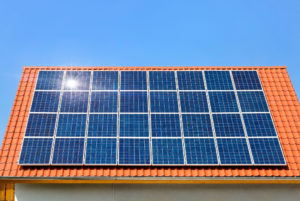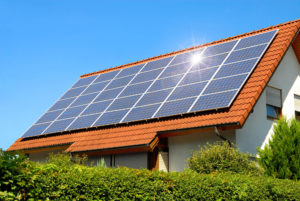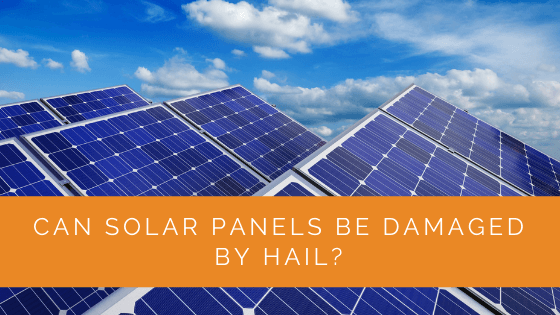Do you reside in a state prone to extreme weather conditions — say heavy rain, even hailstorms? If so, the durability of solar panels against environmental phenomena is likely one of your top concerns.
Well, the good news is solar panels are designed to withstand harsh weather. Not only that, but they undergo thorough testing and certifications to ensure their reliability.
So essentially, you will not have to worry about wrecked solar panels most of the time. That said, these components are susceptible to some amount of damage from extreme hail, much like a car’s windscreen.
Here’s a rundown of everything you need to know about solar panels and hail to satisfy all your queries.
Contents
- 1 Key Takeaways
- 2 What is the Likelihood of Hail Damaging Solar Panels?
- 3 Solar Panel Testing and Certification
- 4 Solar Panels vs. Hail
- 5 How to Check Your Solar Panels for Hail Damage
- 6 How to Reduce Hail Damage Losses for Solar Asset Owners
- 7 Invest in Solar Batteries to Weather Extreme Climate
- 8 Case Study: Ensuring Solar Panel Durability in Hail-Prone Areas
- 9 Expert Insights From Our Solar Panel Installers About Solar Panels and Hail
- 10 Experience Solar Excellence with Us!
- 11 Wrap Up
Key Takeaways
- Solar panels are designed to withstand most weather conditions, including hail, due to their tempered glass and rigorous testing standards in various countries.
- The International Photovoltaic Quality Assurance Task Force (PVQAT) plays a crucial role in testing and certifying the quality and durability of solar panels, ensuring their resilience in adverse weather conditions.
- While solar panels can generally withstand hail, it’s important to inspect them after severe storms for damage, and solar asset owners can take steps to reduce hail damage risks, such as assessing location, requesting hail-resistant testing, and considering design modifications.
What is the Likelihood of Hail Damaging Solar Panels?
Solar panels are usually quite resistant to hailstones. Why? Well, because they are manufactured with tempered glass. The panels then undergo testing to ensure they meet certain standards when it comes to durability.
For instance, in Australia, solar panels should resist direct impact from hailstones having a diameter of 35mm. So roughly, hail the size of a golf ball.
Similarly, in America, manufacturers test their solar panels and certify them capable of withstanding hail with a one-inch diameter. Not only that, but they also test and certify resistance to a certain speed for the falling hail at 50 miles per hour.
That, however, means larger hailstones could potentially smash solar panels. As such, it is always a good idea to let your home insurance provider know that you have solar panels. They will be able to give you clear input into whether your insurance covers hail damage or not.
Solar Panel Testing and Certification
Over the years, the solar industry has seen a lot of advancement in testing and certifications. Naturally, then, analyzing the quality and durability of solar panels is a lot more efficient now. So is assessing their capability to withstand multiple climates and harsh weather.
The International Photovoltaic Quality Assurance Task Force (PVQAT), funded by the SunShot Initiative, is in the driving seat when it comes to this testing. The primary goal of the SunShot Initiative is to economize solar power and make it more accessible across America.
Here’s what the PVQAT’s standardized tests do:
- Measure the ability of the solar modules to resist varying climate conditions.
- Supervise quality management throughout the manufacturing process
- Set guidelines for inspections of system quality, ensuring top-notch solar design and installation
Besides increasing consumer confidence in solar energy systems, the PVQAT’s work serves another crucial purpose. They satisfy the growing demand for clean solar energy despite increased adverse weather conditions due to global warming.

Solar Panels vs. Hail
Thanks to the NREL and the SunShot Initiative’s efforts, solar panels have come a long way in durability and resilience. Extensive testing, including under conditions like hailstorms, has played a major role in this.
For instance, one test involved shooting solar panels with ice balls the size of ping pong balls at 70 mph.
The endeavors of these organizations were tested in 2017 when a particularly harsh hailstorm hit Denver. Across the city, numerous vehicles were left with shattered windows and dents on roofs the size of golf balls. However, only one out of 3,000 of the NREL Denver campus’s solar panels was found damaged.
That in itself is a testament to the rigorous quality testing of solar panels.
How to Check Your Solar Panels for Hail Damage
After a storm, it is best to give your solar panels a once-over, even if nothing seems wrong with the power. It stands regardless of how durable you think the panels are. Here are two simple steps to do that:
- Check the Inverter: Inverters are quick to detect issues in the event of significant hail damage. Take a glance at your inverter’s display screen. Red lights, faults, and no sign of power generation point to an issue that needs to be dealt with by a solar installer.
- Perform a Visual Inspection from Afar: Smashed panels will be easily noticeable from a distance. Avoid climbing onto your roof for a closer inspection, though, as they might be leaking voltage.
How to Reduce Hail Damage Losses for Solar Asset Owners
In most cases, insurers and manufacturers will take responsibility for extreme hail damage. Nevertheless, as a solar asset owner, it would do you well to try to reduce risks as much as possible. This section will cover a few tips to do just that!
1. Appraise Location and Past Weather Events
Analyzing this information can help you predict future weather possibilities. So take a moment to qualitatively determine whether your location is prone to hailstorms with larger hail.
Government climate sources can be a major help when gathering such information. After due consideration and if feasible, you may want to move to a location less susceptible to hailstorms.

2. Test Your Selected Solar Panels for Harsh Hailstorms
You can always request manufacturers to test solar panels at a higher IEC test level with larger iceballs. Or, you could opt for another standard with precise terms for passing.
Typically, an independent quality assurance company can devise such testing protocols. The same company can also verify the results of the test.
Bear in mind, though, that this is relatively new territory. As such, hail-resistant module pricing and terms can vary quite a bit. Some manufacturers may charge more, alter warranty terms, even refuse to bid on the project.
However, the upside is that the more solar asset owners submit hail evaluation requests, the more the likelihood of suppliers responding positively. Not only will they be motivated to develop new modules, but they will also adhere to stricter factory hail standards.
Pay close attention to the language of your supply agreement while drafting it. Ensure that the product specification calls for rigorous testing. Also, make sure it minimizes the supplier’s chances to claim the damage is beyond the scope of the warranty.
3. Contemplate a Change to the Model or Rack
A rather simple way to prevent severe hail damage is to incorporate a single-axis tracker into your setup. Specifically, one that moves into a more vertical position to reduce the impact energy of falling hail. That way, the stones fall as a glancing hit instead of a direct full-on blow.
Besides, you could always opt for models already meeting higher standards. These will usually come with thicker or tempered glass, a stronger frame, thicker encapsulation, support bars, and innovative cell-to-cell interconnection. Needless to say, these also have a heftier price tag.
Invest in Solar Batteries to Weather Extreme Climate
Solar panels are usually more than capable of resisting hail. However, that doesn’t mean that they will always provide power after a storm.
Grid-connected solar panels, especially, are likely to shut off in a power outage even when in perfect working condition.
In such situations, solar batteries can come in handy. They allow continued harnessing of energy from the sun regardless of whether the grid is working or not. Essentially, solar batteries provide electricity to homes while panels continually refill their reserves with solar energy until the grid is running.
Case Study: Ensuring Solar Panel Durability in Hail-Prone Areas
Background
At Solar Panels Network USA, our mission is to provide reliable and durable solar energy solutions that can withstand various environmental challenges. A common concern among our clients, especially those in hail-prone areas, is the potential damage to solar panels from hailstorms. This case study examines how we addressed this concern for a residential client in a region known for frequent hail.
Project Overview
Our client, a homeowner in a hail-prone state, wanted to install solar panels to reduce electricity costs and embrace sustainable energy. However, they were concerned about the durability of the panels during severe hailstorms. Our task was to ensure the installation of a robust solar energy system capable of withstanding such conditions.
Implementation
We began by selecting high-quality solar panels that had undergone rigorous testing and certifications for hail resistance. The chosen panels were certified to withstand impacts from hailstones up to one inch in diameter, traveling at speeds of up to 50 miles per hour.
To further enhance the system’s durability, we incorporated several additional measures:
1. Thorough Testing and Certification: We ensured that the selected panels met the standards set by the International Photovoltaic Quality Assurance Task Force (PVQAT). This included resistance to varying climate conditions and durability under direct impact.
2. Strategic Installation: The panels were installed at an optimal tilt to reduce the impact of hailstones. We used a single-axis tracker system that adjusts the panels’ position to minimize direct hits from hail, effectively allowing the hailstones to glance off rather than strike directly.
3. Regular Inspections: We established a routine inspection schedule, particularly after severe weather events. This proactive approach helps detect any potential damage early and maintain the system’s efficiency.
Results
Following the installation, the region experienced a severe hailstorm. While the storm caused significant damage to vehicles and property, the client’s solar panels remained intact and fully operational. The strategic installation and high-quality panels proved their resilience, providing continuous power without interruption.
The client expressed high satisfaction with the system’s performance and durability, noting the peace of mind that came with knowing their solar investment was well-protected. This successful implementation demonstrated the effectiveness of our approach in ensuring solar panel durability in extreme weather conditions.
Summary
This case study highlights the importance of selecting high-quality, rigorously tested solar panels and employing strategic installation techniques to mitigate the risks of hail damage. At Solar Panels Network USA, we are dedicated to providing solutions that meet our clients’ specific needs, ensuring long-term durability and efficiency of their solar energy systems. By addressing concerns about hail damage proactively, we help our clients embrace sustainable energy with confidence.
Expert Insights From Our Solar Panel Installers About Solar Panels and Hail
As an experienced solar installer, I can confidently say that modern solar panels are designed to withstand most hailstorms. The tempered glass used in these panels is rigorously tested to ensure durability against impacts, including hailstones up to the size of a golf ball.
Senior Solar Technician
While severe hailstorms can pose a risk, the extensive testing and certifications that solar panels undergo ensure that they are highly resistant to damage. Regular inspections after extreme weather can help identify any issues early and maintain the system’s efficiency.
Solar Installation Expert
Investing in high-quality solar panels that have passed rigorous testing for hail resistance is crucial, especially in areas prone to extreme weather. This not only protects your investment but also ensures a consistent power supply even after severe storms.
Lead Solar Engineer
Experience Solar Excellence with Us!
Trust in Solar Panels Network USA, where our seasoned experts deliver top-quality solar solutions for homes and businesses nationwide. With a legacy of countless successful installations and a commitment to sustainable energy, we’re your reliable partner in the solar journey. Ready for a brighter, eco-friendly future? Call us now at (855) 427-0058 and harness the power of the sun!
Wrap Up
On most stormy days, your solar panels will be able to hold up to hail just fine. However, it is when the stones are larger than two inches that you need to worry.
Like the ones present in solar LED lamp posts, panels that are extremely small PV cells are also a tad more prone to damage. That said, most solar panels are designed to weather extreme climate conditions and will not break easily, even under hailstones!
About the Author
Solar Panels Network USA stands at the forefront of solar energy solutions, driven by a team of seasoned solar engineers and energy consultants. With over decades of experience in delivering high-quality solar installations and maintenance, we are committed to promoting sustainable energy through customer-centric, tailored solutions. Our articles reflect this commitment, crafted collaboratively by experts to provide accurate, up-to-date insights into solar technology, ensuring our readers are well-informed and empowered in their solar energy decisions.

